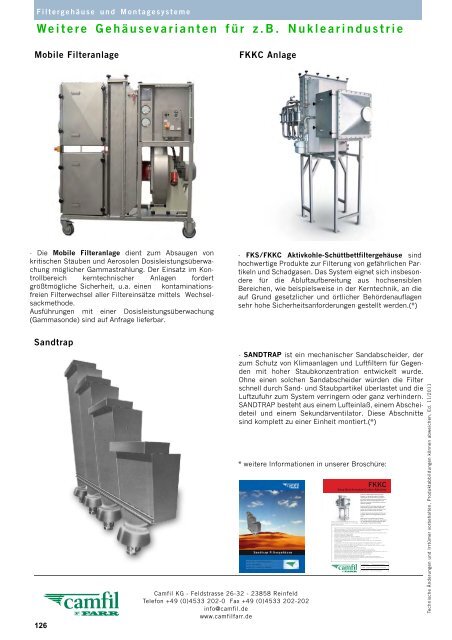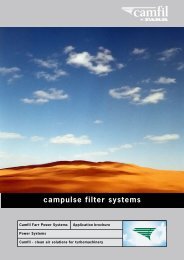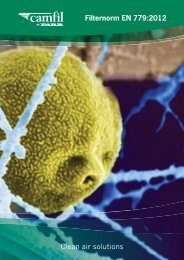Filterklasse F5 - Camfil Farr
Filterklasse F5 - Camfil Farr
Filterklasse F5 - Camfil Farr
Erfolgreiche ePaper selbst erstellen
Machen Sie aus Ihren PDF Publikationen ein blätterbares Flipbook mit unserer einzigartigen Google optimierten e-Paper Software.
Filtergehäuse und Montagesysteme<br />
Weitere Gehäusevarianten für z.B. Nuklearindustrie<br />
Mobile Filteranlage<br />
- Die Mobile Filteranlage dient zum Absaugen von<br />
kritischen Stäuben und Aerosolen Dosisleistungsüberwachung<br />
möglicher Gammastrahlung. Der Einsatz im Kontrollbereich<br />
kerntechnischer Anlagen fordert<br />
größtmögliche Sicherheit, u.a. einen kontaminationsfreien<br />
Filterwechsel aller Filtereinsätze mittels Wechselsackmethode.<br />
Ausführungen mit einer Dosisleistungsüberwachung<br />
(Gammasonde) sind auf Anfrage lieferbar.<br />
Sandtrap<br />
126<br />
FKKC Anlage<br />
<strong>Camfil</strong> KG - Feldstrasse 26-32 - 23858 Reinfeld<br />
Telefon +49 (0)4533 202-0 Fax +49 (0)4533 202-202<br />
info@camfil.de<br />
www.camfilfarr.de<br />
- FKS/FKKC Aktivkohle-Schüttbettfiltergehäuse sind<br />
hochwertige Produkte zur Filterung von gefährlichen Partikeln<br />
und Schadgasen. Das System eignet sich insbesondere<br />
für die Abluftaufbereitung aus hochsensiblen<br />
Bereichen, wie beispielsweise in der Kerntechnik, an die<br />
auf Grund gesetzlicher und örtlicher Behördenauflagen<br />
sehr hohe Sicherheitsanforderungen gestellt werden.(*)<br />
- SANDTRAP ist ein mechanischer Sandabscheider, der<br />
zum Schutz von Klimaanlagen und Luftfiltern für Gegenden<br />
mit hoher Staubkonzentration entwickelt wurde.<br />
Ohne einen solchen Sandabscheider würden die Filter<br />
schnell durch Sand- und Staubpartikel überlastet und die<br />
Luftzufuhr zum System verringern oder ganz verhindern.<br />
SANDTRAP besteht aus einem Lufteinlaß, einem Abscheideteil<br />
und einem Sekundärventilator. Diese Abschnitte<br />
sind komplett zu einer Einheit montiert.(*)<br />
* weitere Informationen in unserer Broschüre:<br />
FKKC<br />
Deep Bed Activated Carbon Adsorber<br />
<strong>Camfil</strong> <strong>Farr</strong> FKKC Deep Bed Activated Carbon<br />
Adsorber is a high quality product, filtering hazardous<br />
gases in sensitive areas. This system is<br />
particularly suited to exhaust ventilation in process<br />
applications where extremely high levels of efficiency<br />
are required to satisfy statutory and local<br />
authority regulations.<br />
Combined with FKS safe change housings, equipped<br />
with filter for particle matters, FKKC filter<br />
systems will effectively remove radioactive or toxic<br />
gaseous and particles from the air stream.<br />
To protect personnel and environment, filters and<br />
activated carbon can be changed without contamination.<br />
FKKC systems are installed in versus Nuclear<br />
Power Plants worldwide and fulfil the requirements<br />
acc. KTA 3601 (German Safety Standard for Ventilation<br />
Systems in Nuclear Power Plants).<br />
• High performance filter system to trap radioactive or toxic gases and particles<br />
Fulfils requirements acc. KTA 3601 (German Safety Standard for Ventilation Systems in Nuclear Power Plants)<br />
Modular and compact design, suitable also for existing plants with difficult installation situation<br />
Many different, customized configurations possible<br />
Housings material: Stainless steel grade 1.4301 (AISI 304), optional higher grades like 1.4404 (AISI 316L)<br />
Decontaminable bead blasted surfaces<br />
Airflows from 2000 up to 30000 m3/h<br />
Activated carbon bed depth from 100 up to 500 mm<br />
Suitable for different high quality activated carbon grades, e.g. “Camcarbon 1,4-2/2/520”<br />
with guaranteed performance acc. KTA 3601 (Methyiodine CH I 3 131 Picture 1: Example of a FKKC Deep Bed Activated Carbon<br />
Adsorber in a compact design incl. a 4 line bypass<br />
adsorber device (Option)<br />
-test)<br />
Activated carbon leakage avoidance due to an additional reserve volume for a self-replenishment<br />
of the filter bed<br />
In combination with FKS safe change housings, equipped with adapted particle filters, an effective<br />
particle filtration is secured. A typical filter configuration is: Pre Filters: G4-F9 acc. EN 779 /<br />
HEPA-Filters: H13-H14 acc. EN 1822 / Activated carbon filter bed / Abrasion-Filters: H11 acc. EN1822<br />
Proven tightness according DIN 25496, table 3<br />
(German Norm for Ventilating Components in Nuclear Facilities)<br />
Activated carbon filling with pneumatic injector device (accessory / see picture 4)<br />
Activated carbon sampling by using a zone sampler (accessory / see picture 5) and<br />
DN 25 ports within the carbon bed lid / Optional: 3 to 5 line bypass adsorber device (accessory / see pic. 7)<br />
Contamination free activated carbon change by using the FKKC-Discharge-Port<br />
(see picture 6 / gravimetric deflation into a drum beneath the carbon bed)<br />
Alternative: Mobile pneumatic withdrawal unit (see picture 8)<br />
Versus options available: e.g. Radioactivity Monitoring System / HEPA-Filter Scantest System /<br />
Pressure release filter device to equalize pressure inside and outside the system during maintenance...<br />
FKKC-Filter Unit installation and training (optional)<br />
<strong>Camfil</strong> <strong>Farr</strong> Productinformation<br />
FKKC - Deep Bed Activated Carbon Adsorber<br />
<strong>Camfil</strong> <strong>Farr</strong> - clean air solutions<br />
Technische Änderungen und Irrtümer vorbehalten, Produktabbildungen können abweichen. Ed. 11/2011




